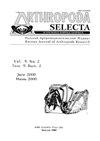Spatial distribution of spiders (Aranei) and other groups of soil macrofauna in the arctic tundra of northeastern Taimyr, Russia
IF 0.7
4区 农林科学
Q4 ENTOMOLOGY
引用次数: 1
Abstract
. Numerous materials have been pro-cessed on soil invertebrates collected by the International Arctic Expedition of the Institute for Evolutionary Morphology and Animal Ecology, Russian Academy of Sciences in 1991 in arctic tundra of eastern Taimyr, near Pronchishchev Lake. The samples re-vealed six spider species of the only family Linyphiidae, all of them being typical purely arctic. The most common species were Erigone psychrophila Thorell, 1872, Hilaira gertschi Holm, 1960 and Semljicola arcticus (Eskov, 1989). The first two species inhabited all the studied biotopes, whereas E. psychrophila was su-perdominating in each of these biotopes. The fauna of spiders of zonal communities was poorer than that in intrazonal ones (3–4, vs 4–6 species). Spiders play the main role in the structure of the soil macrofauna population of arctic tundra of eastern Taimyr. This group is the most diverse, is the most vast component of the macrofauna, and most earlier in the activity after the winter diapause. The second important group are the beetles (Carabidae and Staphylinidae). While spiders are primary in abundance and the share in the total macrofauna in zonal communities, the intrazonal biotopes are characterized by approximate parity of these groups. The share of spiders in the macrofauna decreases during the summer due to diapause end in other invertebrate groups: the soil samples show a decrease from 38% in June to 30% in July, the data from pitfall traps show a decrease from 75% to 38%. In soil samples, spiders comprised 23–50% of the number of all soil macrofauna in the beginning of vegetation season (June), while declining to 18–36% in the mid-season (July). The total number of soil macrofauna in zonal communities is about twice lower on the average than that in intrazonal ones (82, vs 149 spms/m 2 ); the number of spiders is 1.5 times lower (31, vs 48 spms/ m 2 ), that of beetles is almost 4 times lower (16, vs 62 to get a more complete representation of araneofauna of local arctic tundra of eastern Taimyr.俄罗斯泰米尔东北部北极冻土带蜘蛛(Aranei)和其他类群土壤大型动物的空间分布
. 对1991年俄罗斯科学院进化形态学与动物生态学研究所国际北极考察队在靠近普罗奇什切夫湖的泰米尔东部北极冻土带采集的土壤无脊椎动物进行了大量的研究。这些样本揭示了Linyphiidae唯一家族的六种蜘蛛,它们都是典型的纯北极蜘蛛。最常见的种是Erigone psychrophila Thorell(1872)、Hilaira gertschi Holm(1960)和Semljicola arcticus (Eskov, 1989)。前两种占据了所有研究的生物群落,而嗜冷棘球绦虫在每个生物群落中都占绝对优势。地带性群落蜘蛛区系较地带性群落少(3-4种,4-6种)。蜘蛛在泰米尔东部北极冻土带土壤大型动物种群结构中起主要作用。这一类群是最多样化的,是大型动物群中最庞大的组成部分,也是冬季滞育后活动最早的。第二个重要的类群是甲虫(甲虫科和葡萄虫科)。在地带性群落中,蜘蛛的数量和份额都是主要的,但在地带性群落中,这些类群的数量基本相等。由于其他无脊椎动物群的滞育结束,蜘蛛在大型动物群中的份额在夏季下降:土壤样品显示从6月的38%下降到7月的30%,陷阱数据显示从75%下降到38%。在土壤样品中,蜘蛛在植被季初(6月)占所有土壤大型动物数量的23-50%,在植被季中期(7月)下降到18-36%。地带性群落的土壤大型动物总数平均比地带性群落少2倍左右(82只比149只);蜘蛛的数量是前者的1.5倍(31只比48只),甲虫的数量几乎是后者的4倍(16只比62只),从而更完整地代表了泰米尔东部当地北极冻土带的动物种类。
本文章由计算机程序翻译,如有差异,请以英文原文为准。
求助全文
约1分钟内获得全文
求助全文
来源期刊

Arthropoda Selecta
Agricultural and Biological Sciences-Insect Science
CiteScore
1.60
自引率
33.30%
发文量
44
期刊介绍:
The open-access, peer-reviewed journal is published mostly in English. The scope of the journal is the morphology, taxonomy, development, life histories, zoogeography, phylogeny and evolution of Crustacea, Chelicerata, Myriapoda and other arthropods, both recent and fossil.
 求助内容:
求助内容: 应助结果提醒方式:
应助结果提醒方式:


